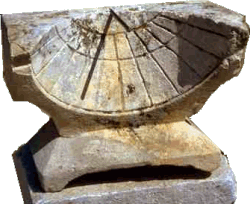|
If you ask anyone what time it is, you will be sure to receive several different answers! For, as Seneca states, it is impossible in Rome to be sure of the exact hour; and it is easier to get the philosophers to agree among themselves than the clocks: "Horam non possum certam tibi dicere: facilius inter philosophos quam inter horologia convenit."
Time was not an exact thing in ancient Rome. Hours were originally calculated for daytime; and even when the invention of the horologia ex aqua, or water-clock made it possible to calculate the night hours by a simple reversal of the data that the sundial first had given, it did not succeed in unifying the hours.
 While modern hours are all sixty minutes of sixty seconds in length, and each hour is definitely separated, the lack of division with Roman hours meant that each stretched over the interval of time between the preceding hour and the hour which followed. Instead of being of fixed duration, this interval changed constantly, now longer, now shorter, from one end of the year to the other! While modern hours are all sixty minutes of sixty seconds in length, and each hour is definitely separated, the lack of division with Roman hours meant that each stretched over the interval of time between the preceding hour and the hour which followed. Instead of being of fixed duration, this interval changed constantly, now longer, now shorter, from one end of the year to the other!
On any given day, the duration of the day hours was different than the length of the night hours. The twelve hours of day were divided between the rising and the setting of the sun; conversely, night hours were divided between sunset and sunrise. So clearly when the day hours were longer in summer, the night hours were shorter, and vice versa.
Day and night hours were equal only twice a year: at the vernal and autumnal equinoxes. They lengthened and shortened in inverse ratio until the summer and winter solstices, when the discrepancy between the hours was greatest. At the winter solstice (December 22), when the day had only 8 hours and 54 minutes of sunlight against a night of 15 hours and six minutes, the day hour was only a little over to 44 minutes long while the night hour lengthened to one hour and 15 minutes. At the summer solstice the position was exactly reversed; the night hour was shortest while the day hour reached its maximum length.
At the Winter solstice, hours were approximately as follows:
|
|
I
|
Hora prima |
from |
7:33
|
to |
8:17 AM
|
|
II
|
Hora secunda |
from |
8:17
|
to |
9:02 AM
|
|
III
|
Hora tertia |
from |
9:02
|
to |
9:46 AM
|
|
IV
|
Hora quarta |
from |
9:46
|
to |
10:31 AM
|
|
V
|
Hora quinta |
from |
10:31
|
to |
11:15 AM
|
|
VI
|
Hora sexta |
from |
11:15
|
to |
12:00 noon
|
|
VII
|
Hora septima |
from |
12:00
|
to |
12:44 PM
|
|
VIII
|
Hora octava |
from |
12:44
|
to |
1:29 PM
|
|
IX
|
Hora nona |
from |
1:29
|
to |
2:13 PM
|
|
X
|
Hora decima |
from |
2:13
|
to |
2:58 PM
|
|
XI
|
Hora undecima |
from |
2:58
|
to |
3:42 PM
|
|
XII
|
Hora duodecima |
from |
3:42
|
to |
4:27 PM
|
At the Summer solstice, hours of the day ran approximately as follows
|
|
I
|
Hora prima |
from |
4:27
|
to |
5:42 AM
|
|
II
|
Hora secunda |
from |
5:42
|
to |
6:58 AM
|
|
III
|
Hora tertia |
from |
6:58
|
to |
8:13 AM
|
|
IV
|
Hora quarta |
from |
8:13
|
to |
9:29 AM
|
|
V
|
Hora quinta |
from |
9:29
|
to |
10:44 AM
|
|
VI
|
Hora sexta |
from |
10:44
|
to |
12:00 noon
|
|
VII
|
Hora septima |
from |
12:00
|
to |
1:15 PM
|
|
VIII
|
Hora octava |
from |
1:15
|
to |
2:31 PM
|
|
IX
|
Hora nona |
from |
2:31
|
to |
3:46 PM
|
|
X
|
Hora decima |
from |
3:46
|
to |
5:02 PM
|
|
XI
|
Hora undecima |
from |
5:02
|
to |
6:17 PM
|
|
XII
|
Hora duodecima |
from |
6:17
|
to |
7:33 PM
|
Night hours were reversed in length with maximum length at the winter solstice and minimum length at the summer solstice.
Something as simple as telling time had an enormous effect on Roman life. For one thing, as the methods of measuring the hours was inexact, Roman life was never regulated to the degree that the above schedule indicates. Busy as life was in the Urbs, it continued to have flexibility unknown to modern-day citizens.
As the length of the Roman day changed constantly with the seasons, life went through phases whose intensity varied with the hours: less productive in winter, more productive as the days lengthened. In this way, the character of Rome maintained a strong link with its agrarian roots.
- - from Daily Life in Ancient Rome, by Jerome Carcopino, Yale University Press
VILLA > MEASURING TIME
|
